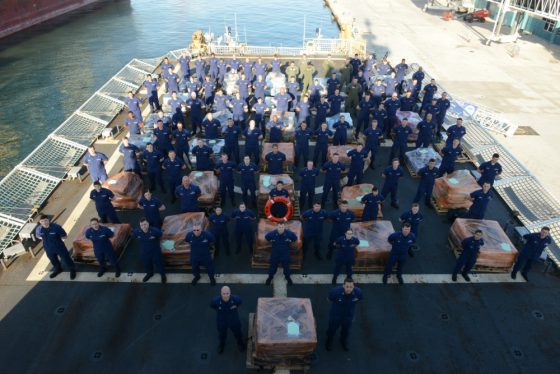
As the nation’s first line of defense against drug smugglers seeking to bring illegal substances into the United States, the Coast Guard’s counternarcotics operations are part of a government effort to dismantle transnational organized crime networks from increasing violence and instability in the Western Hemisphere.
That is where hard working crews like the one assigned to Coast Guard Cutter James come in! The crew offloaded approximately 16 tons of cocaine Mar. 28, 2017 in Port Everglades, Fla. This interdiction was worth an estimated $420 million wholesale seized in international waters off the Eastern Pacific Ocean.
The drugs were interdicted along Central and South America by Coast Guard and Canadian ships sailing with an embarked Coast Guard Law Enforcement Detachment (LEDET) team during a 26-day period.
The offload represents 17 separate suspected drug smuggling vessel interdictions by U.S. Coast Guard crews, Canadian crews and interagency partners:
– The cutter James and HITRON were responsible for five cases, seizing an estimated 5.19 tons of cocaine.
– The cutter Mohawk was responsible for seven cases, seizing an estimated 5.79 tons of cocaine.
– The cutter Sherman was responsible for one case, seizing an estimated 1 ton of cocaine.
– The cutter Tampa was responsible for three cases, seizing an estimated 3 tons of cocaine.
– HMCS Saskatoon and Coast Guard LEDET 405 were responsible for one case, seizing an estimated 1 ton of cocaine.
Video: The Coast Guard Cutter James and crew members from Helicopter Interdiction Tactical Squadron conduct training and demonstrations while underway in the Atlantic Ocean Mar. 29, 2017.
Numerous U.S. agencies from the Departments of Defense, Justice and Homeland Security are involved in the effort to combat transnational organized crime. The Coast Guard, Navy, Customs and Border Protection, FBI, Drug Enforcement Agency, and Immigration and Customs Enforcement along with allied and international partner agencies play a role in counter-drug operations. The fight against transnational organized crime networks in the Eastern Pacific requires unity of effort in all phases from detection, monitoring and interdictions, to prosecutions by U.S. Attorneys in California, on the East Coast and in the Caribbean.
“I am extremely proud of the crew of Coast Guard Cutter James and our embarked HITRON aviation detachment for a highly successful inaugural patrol,” said Vice Adm. Karl Schultz, commander of Coast Guard Atlantic Area. “Our persistent maritime presence in drug trafficking zones from cutters like James, enables us to interdict bulk quantities of drugs at sea, preventing criminal networks’ illicit cargoes from reaching the shores of Central America, and land routes into the United States.”
The Coast Guard increased U.S. and allied presence in the Eastern Pacific Ocean and Caribbean Basin, which are known drug transit zones off of Central and South America, as part of its Western Hemisphere Strategy. During at-sea interdictions in international waters, a suspect vessel is initially located and tracked by allied military or law enforcement personnel. The interdictions, including the actual boarding, are led and conducted by U.S. Coast Guard personnel. The law enforcement phase of counter-smuggling operations in the Eastern Pacific is conducted under the authority of the 11th Coast Guard District headquartered in Alameda, Calif.
The cutter James is a 418-foot national security cutter homeported in Charleston, S.C. The cutter Sherman is a 378-foot high-endurance cutter homeported in Honolulu. The cutters Mohawk and Tampa are 270-foot medium-endurance cutters homeported in Key West, Fla. and Portsmouth, Va. respectively. The HMCS Saskatoon is a Kingston Class coastal defence vessel based in Esquimalt, British Columbia, Canada.

